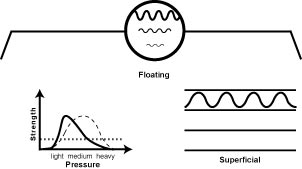The Floating, Superficial Pulse (Fu Mai)

Floating Pulse (?? Fu Mai, superficial)
Key point: superficial
Indications: exterior condition: defensive yang mobilizes externally bringing with it the qi and blood, resulting in the floating pulse.
Yin deficiency: yin cannot anchor yang. Yang is “up” and yin is “down”. The floating pulse therefore may be described as the pulse that lacks “down” (also known as “root”).
Explanation: “floating” means the pulse is more evident when pressing lightly and as you press with more conviction, the pulse is no longer felt. Floating thus is a deficiency of root, or “down” sensation. Down is yin, up is yang. A lack of down suggests a deficiency of yin. Get it? That’s the internal reason, there’s an external reason too.
If one is fighting off an external attack of cold, heat or whatever, the defensive yang (also know as wei or defensive qi) will rise up against the offending pathogen. As the yang rises outwardly, so does the blood giving rise to the floating pulse.
Ultimately, the floating pulse could be described as an internal deficiency (of yin) or external excess (of yang fighting off pathogenic factors).

The Floating Pulse
Next: let’s go deep.
 Last modified: August 14, 2009
Last modified: August 14, 2009  Tags: Diagnosis, Practitioners · Posted in: Pulse Class, Pulse-Palpation
Tags: Diagnosis, Practitioners · Posted in: Pulse Class, Pulse-Palpation
